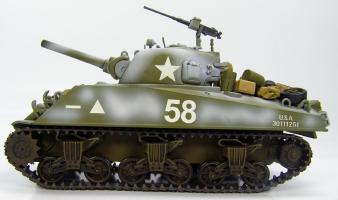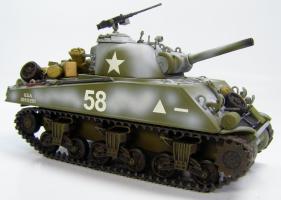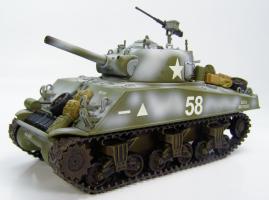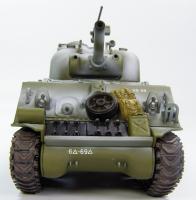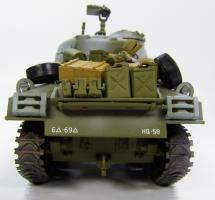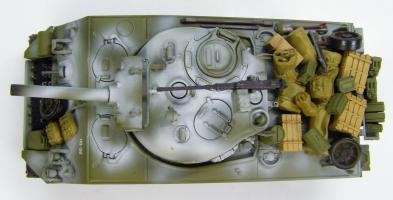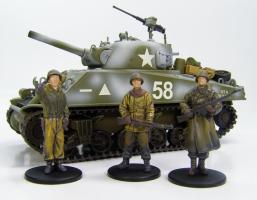Hobby Master Archive
Ground Power 1/48
Sherman
Sherman M4A3 105MM Howitzer H company, 69th Tank Bttn., 6th Armor Div., Ardennes, Belgium, December, 1944, Battle of the Bulge
Specifications for M4 Sherman 105mm Howitzer Dimensions Overall length: 6.197m Overall width: 2.67m Overall height: 2.94m Weight Weight, Combat Loaded: 31.48t Weight, Un-stowed: 28.486t Armor Actual Thickness, Angle w/Vertical Hull Thickness: Front: 63mm/47 degrees Sides: 38mm/0 degrees Rear: 38mm/10 degrees Top: 19mm/83-90 degrees Turret Thickness: Front: 76mm/30 degrees Sides: 51mm/0-5 degrees Rear: 51mm/0 degrees Top: 25.4mm/90 degrees Gun Shield: 91mm/0 degrees Armament M4 105mm howitzer (X1), M1919A4 7.62mm machine gun (X2), M2 12.7mm heavy machine gun (X1). Ammunition: 66 rounds 105mm, 4,000 rounds 7.62mm, 600 rounds 12.7mm.
Powerplant Engine: Continental R975-C4 9-cylinder 4-cycle radial air cooled (15,945cc displacement, 460hp/2,400rpm output) Maximum speed: 38.6hm/h, Cruising Range: about 161km, Crew: 5
Hobby Master 1/48 Ground Power Series HG1003 Sherman M4A3 105MM Howitzer H company, 69th Tank Bttn., 6th Armor Div. Ardennes, Belgium, December, 1944, “Battle of the Bulge” Model comes with 3 figures
Authentic Detailing Pre-Painted by professionals Accurate paint colors Markings Tampo (pad) applied Fully Assembled Die-Cast Model True to Scale (1:48) Weathering and insignias Turret turns Main gun elevates Metal chassis, hull, turret and main gun Realistic tracks
The 69th Armored Regiment was constituted July 1940 and September 1943 became the 69th Tank Battalion. They entered the war July 27, 1944 with the 6th Armored Division at Normandy. They joined Patton’s 3rd Army and fought across northern France taking part in the Battle of the Bulge at Bastogne. They all continued their push eastward and the 69th Tank Battalion war ended near Leipzig. On July 11, 1945 they were relieved from assignment and became an amphibious tractor battalion. March 8,1946 they were inactivated.
History of the Sherman M4 105mm Howitzer The prototype of the M4 nicknamed the “General Sherman” by British troops was designated the T-6 and appeared in September 1941. This medium tank would go on to be one of the most important pieces of armor in WW II. Its production number of approximately 55,000 of all versions was only surpassed by the Soviet T-34 57,000 of all its versions. About 44,000 were armed with the 75mm Gun M3, with 6,465 76mm Gun M1, and later in the war 4,180 armed with the 105mm Howitzer M4 were introduced. At production start up 1,000 units a month came off the assembly line with that number increasing to 2,000 per month when all 11 plants were up and running. The first “Sherman” to be thrown into battle was the 75mm gun version. In one version or another the “Sherman” would see action in all theaters of operation throughout WW II. Since there wasn’t any other tank available in any great numbers the M4 was tasked to do jobs that it was never designed for. Within a year of being introduced in Europe the original version was found to be obsolete because it just couldn’t handle the battle conditions and opposition equipment. The Army and Marines realized this so in 1943 a firm commitment to “win the war” was made and the Sherman would be the vehicle to use. Major improvements were needed and they included a new 76mm main gun that had a much higher muzzle velocity than the 75mm and this greatly improved the penetrating ability of the “Sherman” shells. The other major improvement was the introduction in July 1944 of the 105mm Howitzer, it would provide heavy front line fire support for the U.S. Army and Marines as well as extensive use in anti- tank operations. The 76mm produced at the Detroit Tank Arsenal now used what was referred to as “wet” ammunition stowage. The ammunition was actually stowed in water-protected racks below the turret instead of in the sponsons. Ten boxes on the hull floor held 100 rounds and needed 37.1 gallons of water with a further gallon being needed to protect the four ready rounds. The water contained ethylene glycol to prevent freezing and a corrosion inhibiter known as “Ammudamp”. This version helped prevent internal fires and explosions when hit. This occurrence was common knowledge as the Americans’ nickname for the Sherman was the ZIPPO (lights first time, every time), while the Germans called it the TOMMY COOKER. 105mm howitzer armed variants didn’t use “wet” ammunition storage they used armored racks. Floor ammunition racks required that the turret basket be eliminated with a partial floor suspended from the turret ring. The 105mm howitzer was carried in a M52 combination mount and a vision cupola was fitted for the commander with a small hatch for the loader. It could fire M1 shells at angles from -10 to +35 degrees at a maximum range of 11500m. Out of the 4,180 armed with the 105mm Howitzer M4 about 500 were produced at the Chrysler factory in Detroit from May to September 1944. Besides the increased size of the main gun the most noticeable external feature is the 47 degree front hull with a newly designed and much larger driver /assistant driver hatches. Also from September 1944 (HVSS) horizontal volute spring suspension was introduced on the M4A3 (105mm) together with the wider center-guide T66 tracks. All U.S. Army M4s were equipped with a .50cal Browning Machine Gun M2-HB in a pintle mount on the turret. The M4 105mm was a great consumer of ammunition because of its use as fire support just like regular field artillery.
THESE ARE PRE-PRODUCTION PICTURES NOT THE RETAIL VERSION
69th Armor Regiment emblem (Black Panther) motto: “Vitesse Et Puissance”(“Speed and Power”)
| Added to archive | 2015-11-19 |
| Last modified | 2015-11-19 |

